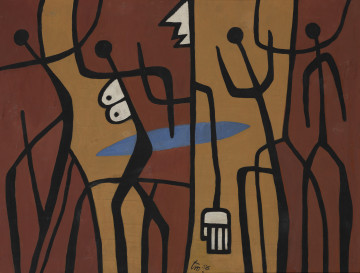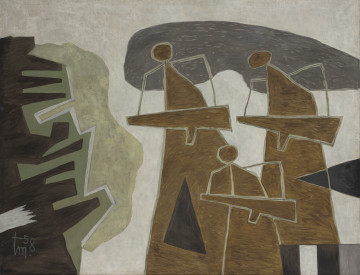
Dance
1956
National Museum in Szczecin
Part of the collection: European classics of modernity
Moscow-born Marian Tomaszewski (1904-1968) began his education in a Russian gymnasium but moved to Poland with his parents after the October Revolution. He passed his baccalaureate examinations at the Juliusz Słowacki State Teachers' Seminary in Lublin (1926). It enabled the future painter to find employment in the educational sector, in which he was active almost his entire professional life. After receiving his diploma from the Warsaw Academy of Fine Arts, he began teaching the art of drawing in the capital city's secondary schools. During the Nazi occupation, the artist returned to Lublin, where he became an instructor at the art courses of Janina Miłosiowa (1896-1983) and subsequently at the German School of Painting and Drawing. Alongside his teaching career, Tomaszewski was involved in underground cultural life. After the liberation of the city, he created the foundations of an institution with the Provisional Board of the Trade Union of Visual Artists, of which he became president. His experiences in Lublin led him to be entrusted with organising artistic life in Szczecin, where he arrived in September 1945. At the Provincial Department of Culture and the Arts, he was a specialist in the arts; at the local branch of the ZZAP - he was a vice president; he also founded the Society for the Promotion of Culture in Western Pomerania and the Free College of Visual Arts (from 1947 the School of Visual Arts, and from 1948 the National Visual Arts Cultural Centre), of which he became director. Wartime memories and pioneering work became an influential theme in his works. The painting A standard above (1947), which is in the style of the favourite Parisian painters Fernand Léger (1881-1955) and Pablo Picasso (1881-1973) and alludes to the concept of primitive art, depicts a scene of reconstruction. The multiplication of a figure with a hammer in his hand, shown against a fragment of a wall with a similar outline, conveys the idea of the unity of workers' enthusiasm, which corresponds to the propaganda slogans of the strengthening communist government. Despite Tomaszewski's return to Warsaw in 1951, both social and professional contacts linked the artist to West Pomerania for the rest of his life. Szymon Piotr Kubiak
Author / creator
Object type
painting
Technique
oil technique
Material
chipboard
Origin / acquisition method
purchase
Creation time / dating
Creation / finding place
Owner
Muzeum Narodowe w Szczecinie
Identification number
Location / status

1956
National Museum in Szczecin

1958
National Museum in Szczecin

między 1958 — 1965
National Museum in Szczecin
DISCOVER this TOPIC
Castle Museum in Łańcut
DISCOVER this PATH
Educational path